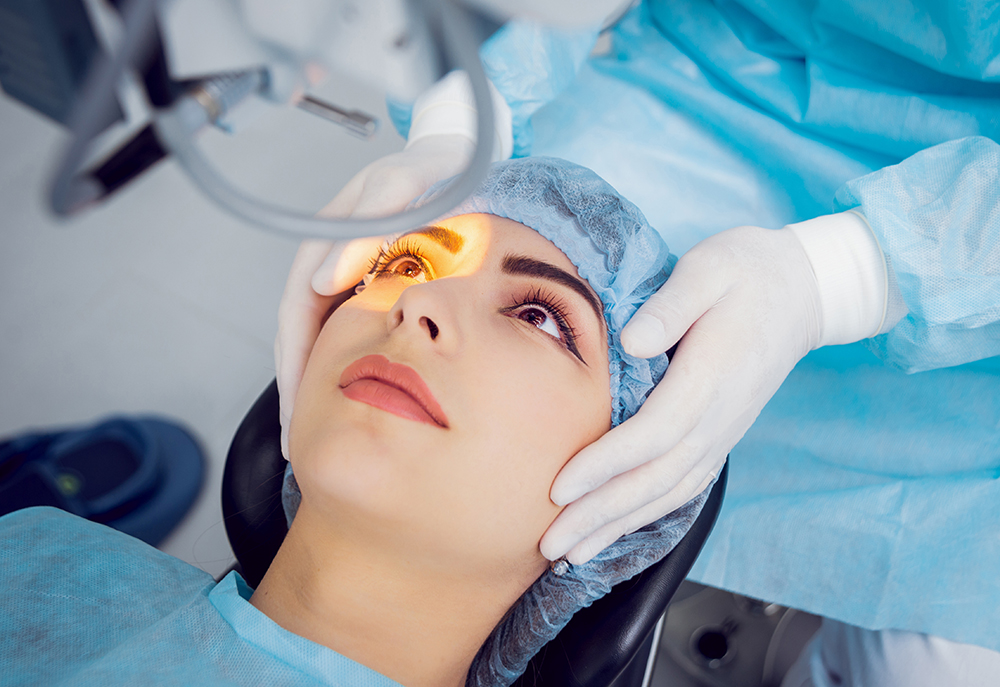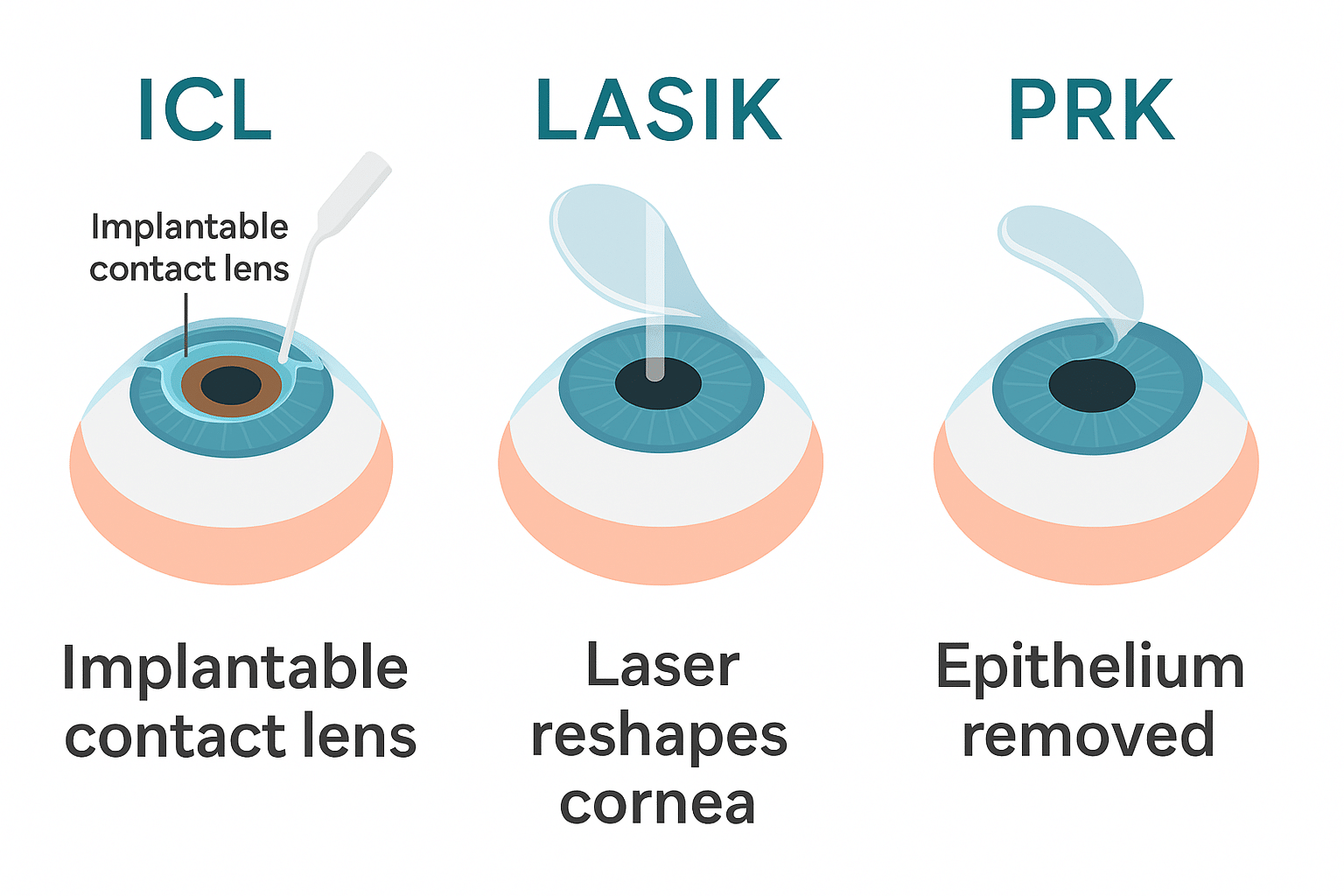Confused about the differences between ICL, LASIK, and PRK vision surgery? You’re not alone. These procedures help over 90% of patients achieve 20/20 vision or better. The results can change your life—but you need to know which option works best for you.
Your vision correction journey depends on the surgical approach you choose. LASIK patients notice better vision within 24-48 hours, making it popular for its quick recovery. PRK gives you the same benefits without creating a corneal flap, which works great if you have thin corneas. ICL stands out as a reversible option with impressive stats—99% of patients are satisfied, and the surgery takes under 20 minutes. Doctors complete all these procedures on an outpatient basis in less than an hour, but each one suits different prescriptions and eye conditions.
You might want LASIK or PRK to fix moderate vision problems. Or perhaps ICL could be your answer for severe myopia (prescriptions between −3D and −20D). This piece will show you how each procedure matches your vision needs and fits your lifestyle.
LASIK: Fast Results with Minimal Downtime
LASIK remains the top choice for refractive laser surgery. This remarkable procedure delivers excellent vision correction results while patients recover quickly. The popularity of this treatment continues to grow as more people seek freedom from glasses and contact lenses.

How LASIK Works: Corneal Flap and Laser Reshaping
The surgery reshapes your cornea to fix refractive errors that blur vision. Your surgeon starts this 30-minute outpatient procedure by applying numbing eye drops. They create a thin corneal flap (about 110 microns thick) and fold it back. An excimer laser precisely reshapes the corneal tissue underneath. The surgeon repositions the flap, which starts healing right away without needing stitches.
Ideal Candidates: Moderate Refractive Errors and Healthy Corneas
Good candidates should be at least 18 years old (21 in some cases) and have maintained stable vision for a year or more. The procedure works well for nearsightedness up to -12.00 diopters, farsightedness up to +6.00 diopters, and astigmatism up to 6.00 diopters. Patients need corneal thickness of 500 microns or more. People with autoimmune disorders, uncontrolled diabetes, or severe dry eye should look for other options.
Pros: Quick Recovery, High Success Rate
Quick recovery stands out as a major benefit. Vision improves within hours, though some blurriness might occur initially. About 96% of patients achieve 20/40 vision or better without glasses. The success rate soars with more than 90% reaching 20/20 vision. Patients usually drive and return to work within 24-48 hours. Complete healing and vision stabilisation takes 3-6 months.
Cons: Dry Eyes, Not for Thin Corneas
LASIK comes with some challenges. Dry eye affects about 95% of patients right after surgery. Most people see these symptoms peak early and improve within 6-12 months after the procedure. Notwithstanding that, LASIK might not suit everyone. Patients with corneas thinner than 470 microns, unstable vision, or certain medical conditions should think over alternatives like PRK or ICL.
PRK: A Flap-Free Option for Active Lifestyles
PRK gives you a unique way to correct your vision, especially when you have an active lifestyle or specific corneal features. It differs from other procedures because it removes certain eye tissue instead of preserving it. This creates a completely different surgical experience and recovery process.
How PRK Works: Surface Reshaping Without a Flap
The PRK procedure corrects vision by removing the cornea’s outer layer (epithelium) with a solution, brush, or laser instead of creating a corneal flap. An excimer laser reshapes the underlying corneal tissue to fix refractive errors. Your surgeon then places a bandage contact lens over your eye. This lens protects the exposed tissue and helps it heal. You’ll wear this lens for 5-7 days while your epithelium naturally grows back.
Best For: Thin Corneas and Contact Sport Athletes
PRK works great if you have thin corneas that rule out LASIK. So, doctors often recommend it to people who play contact sports, serve in the military, or work in environments with potential eye trauma. Athletes and active professionals benefit because PRK doesn’t create a flap that could become dislodged during physical activities.
Pros: No Flap Risks, Suitable for More Patients
PRK eliminates all flap-related complications that can happen with LASIK. Your cornea usually stays structurally stronger after PRK, which leads to better long-term stability. About 90-95% of patients see at least 20/40 without needing glasses or contacts. PRK also helps people with dry eyes because it affects fewer corneal nerves than procedures that create flaps.
Cons: Longer Recovery, More Discomfort
PRK recovery takes much longer than LASIK. Your vision starts improving after 5-7 days but might need several weeks or months to stabilise fully. You’ll likely feel more discomfort for 1-3 days after surgery. The first few days bring blurry vision, sensitivity to light, and sometimes mild pain that needs medication. Full healing and stable vision usually takes 3-6 months.
ICL: Implantable Lens for High Prescriptions
ICL surgery takes a different path than laser-based procedures. It adds eye tissue instead of removing it. This advanced option helps patients see clearly when their prescriptions are too extreme for other methods.

How ICL Works: Collamer Lens Placement Behind the Iris
Your eye surgeon places a soft, flexible lens between your iris (the coloured part of your eye) and your natural lens. The whole thing takes just 15-30 minutes per eye. The implant uses collamer—a biocompatible mix of plastic and collagen. This material stays lightweight, attracts water, and lets nutrients pass through. Your eye accepts the lens naturally and keeps working as it should.
Who Should Consider ICL: High Myopia, Dry Eyes, Thin Corneas
You might be right for ICL if you have:
- Severe nearsightedness from -3D to -20D
- Thin or irregularly shaped corneas that rule out LASIK
- Ongoing dry eye problems
- You’re between 21-45 with stable vision (vision changes less than 0.5D yearly)
ICL has become the go-to choice when your corneas are too thin for laser surgery. This is especially true if your prescription is beyond what LASIK can handle, which is usually -8D to -10D.
Pros: Reversible, UV Protection, Excellent Night Vision
The best part about ICL is that doctors can remove or replace the lens without harming your eye. The collamer material shields your inner eye from UV rays. This might reduce UV damage over time. Patients often say they see better at night with ICL than with LASIK. Your eyes also stay moist because ICL doesn’t affect corneal nerves or tear production.
Cons: Higher Cost, Surgical Invasiveness
ICL surgery runs between £3,177 to £4,400 per eye. This costs more than LASIK, which ranges from £1,191-£2,382 per eye. The procedure goes deeper into your eye instead of just working on the cornea. This means slightly higher risks. You might face issues like endothelial damage, cataracts, higher eye pressure, or infection. All the same, about 95% of patients say they’re happy or very happy with their results.
ICL vs LASIK vs PRK: Which One Fits You Best?
The choice between ICL, LASIK, and PRK depends on your eye characteristics and lifestyle needs. Each procedure has specific requirements that help determine if it suits you.

Corneal Thickness Requirements
Your corneal thickness is a vital factor that determines your eligibility for laser vision correction. LASIK needs a minimum corneal thickness of 500 microns. PRK works on thinner corneas of at least 485 microns. ICL stands out because it doesn’t involve the cornea, which makes it perfect for patients who have thin or irregularly shaped corneas.
Prescription Range Suitability
These procedures treat different prescription strengths. LASIK can treat myopia up to -10.00 diopters, hyperopia up to +6.00 diopters, and astigmatism up to 6.00 diopters. PRK has similar ranges but works better for patients with thinner corneas. ICL excels with high prescriptions—it corrects myopia between -3.00 and -20.00 diopters and astigmatism up to 6.00 diopters.
Recovery Time and Lifestyle Effect
Recovery times vary substantially between procedures. LASIK gives you the fastest recovery, and most patients go back to work within 2-3 days. PRK needs more time, with about a week away from work and full visual recovery taking 1-3 months. ICL falls in the middle – you can return to work within 1-2 days but need about a month for complete visual recovery.
Want to know which vision correction option suits you best? Book a personal consultation with Precision Vision London and let our experts guide your decision with confidence.
Reversibility and Long-Term Flexibility
The main difference between these procedures lies in their permanence. LASIK and PRK reshape your cornea permanently, with no option to reverse. ICL provides a reversible solution—doctors can remove or replace the implanted lens if your vision changes or new technologies emerge. This flexibility makes ICL an attractive choice for younger patients who might see changes in their prescription over time.
Comparison Table
| Feature | ICL | LASIK | PRK |
|---|---|---|---|
| Procedure Type | Implantable lens behind iris | Corneal flap creation and laser reshaping | Surface tissue removal and laser reshaping |
| Duration | 15-30 minutes per eye | About 30 minutes | Not mentioned specifically |
| Prescription Range | -3D to -20D | Up to -12D myopia, +6D hyperopia, 6D astigmatism | Like LASIK |
| Minimum Corneal Thickness | Not required | 500 microns | 485 microns |
| Original Recovery Time | 1-2 days to return to work | 24-48 hours | 5-7 days |
| Full Vision Stabilisation | About 1 month | 3-6 months | 3-6 months |
| Core Team Advantages | - Reversible procedure - Built-in UV protection - Better night vision - No effect on dry eye | - Quickest recovery - 96% achieve 20/40 or better - Immediate vision improvement | - No flap complications - Stronger corneal structure - 90-95% achieve 20/40 or better |
| Biggest Disadvantages | - Higher cost (£3,177-£4,400 per eye) - More invasive procedure - Higher surgical risks | - Dry eye symptoms - Flap complications possible - Not suitable for thin corneas | - Longer recovery time - More initial discomfort - More post-op pain |
| Best Suited For | - High myopia patients - Thin corneas - Dry eye sufferers - Ages 21-45 | - Moderate vision problems - Sufficient corneal thickness - Stable vision - 18+ years old | - Thin corneas - Athletes/active lifestyle - Military personnel - Contact sport participants |
Conclusion
Making a choice between ICL, LASIK, and PRK depends on your eye characteristics and lifestyle needs. You need to understand how these procedures are different to make the right choice about your vision correction.
Each procedure comes with its own benefits. LASIK gives you quick recovery and great results. This makes it perfect if you have thick enough corneas and moderate vision problems. PRK works well for people with thin corneas or active lifestyles, but you’ll need more patience while recovering. ICL costs more but brings amazing results for people with very high prescriptions or corneas that won’t work with other procedures. Plus, you can reverse it if needed.
Your prescription, corneal thickness, and lifestyle will help determine the best procedure for you. Want to know which vision correction option fits your needs? Our experts at Precision Vision London can help you decide – just book a personal consultation.
Vision correction surgery is a life-changing chance to break free from glasses and contact lenses. These procedures have success rates over 90%, so you can look forward to seeing clearly and enjoying the freedom it brings. While each path to better vision is different, they all lead to the same place – seeing the world through your own eyes, naturally and clearly.
FAQs
Q1. What are the main differences between ICL, LASIK, and PRK? ICL involves implanting a lens behind the iris, LASIK creates a corneal flap for laser reshaping, and PRK removes surface tissue for laser reshaping. ICL is suitable for higher prescriptions and thinner corneas, while LASIK and PRK are better for moderate vision problems.
Q2. How long does recovery take for each procedure? LASIK offers the quickest recovery, with most patients returning to work within 24-48 hours. ICL patients typically return to work in 1-2 days. PRK has the longest initial recovery, with most people taking about a week off work, and full visual recovery can take 1-3 months.
Q3. Which procedure is best for people with thin corneas? PRK and ICL are generally better options for those with thin corneas. PRK can be performed on corneas as thin as 485 microns, while ICL doesn’t involve corneal reshaping at all, making it suitable for very thin or irregularly shaped corneas.
Q4. Is there a reversible option among these procedures? Yes, ICL is the only reversible option among the three. The implanted lens can be removed or replaced if needed, whereas LASIK and PRK permanently reshape the cornea and cannot be reversed.
Q5. What are the success rates for these vision correction procedures? All three procedures have high success rates. About 96% of LASIK patients achieve 20/40 vision or better without glasses. For PRK, approximately 90-95% of patients achieve at least 20/40 vision. ICL has a 99% patient satisfaction rate, with many patients reporting improved night vision and contrast sensitivity.
Authors & Reviewer
-
 Olivia: Author
Olivia: AuthorHi, I'm Olivia, a passionate writer specialising in eye care, vision health, and the latest advancements in optometry. I strive to craft informative and engaging articles that help readers make informed decisions about their eye health. With a keen eye for detail and a commitment to delivering accurate, research-backed content, I aim to educate and inspire through every piece I write.
-
 Dr. CT Pillai: Reviewer
Dr. CT Pillai: ReviewerDr. CT Pillai is a globally recognised ophthalmologist with over 30 years of experience, specialising in refractive surgery and general ophthalmology. Renowned for performing over 50,000 successful laser procedures.

